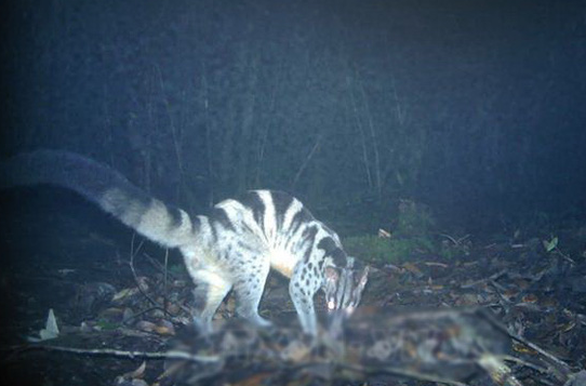A new survey has revealed surprising mammal biodiversity, including seven rare and endangered species, in Bidoup – Nui Ba National Park in the Central Highlands province of Lam Dong.
According to national park director Dr. Le Van Huong, the camera-trap survey was jointly carried out by the park’s management board, the Southern Institute of Ecology, and the Leibniz Institute for Zoo and Wildlife Research (Leibniz - IZW) from Germany on the site from October 2019 to March 2020.
The first camera-trapping data from the ongoing study revealed an exceptionally high mammalian diversity with at least 21 mammal species, seven of which are globally threatened.
The most important findings of the species survey are several camera trap images of the large-antlered muntjac (Muntiacus vuquangensis), a critically endangered deer species that can only be found in the Truong Son Mountain Range, which stretches from Vietnam’s north to Lam Dong and is featured on the International Union for Conservation of Nature (IUCN) Red List of Critically Endangered Species.
Conservationists believed the species was extinct in most forests in Vietnam.
In addition to the large-antlered muntjac, the camera traps also recorded another species confined to the Truong Son Mountain Range, the Owston’s civet (Chrotogale owstoni).
Nguyen The Truong An, field coordinator with Leibniz-IZW, said the Bidoup – Nui Ba National Park is one of just a few nature reserves in Vietnam to be home to the civet, a cat-like species.
This strikingly-patterned small carnivore is now close to extinction as a result of widespread poaching to supply the wildlife bushmeat trade in Vietnam.
 |
| The image of an albino porcupine captured by camera traps at the Bidoup – Nui Ba National Park in Lam Dong Province, Vietnam. Photo: Vietnam News Agency |
One of the most unexpected findings was a set of images of an albino porcupine.
Although porcupines are still relatively abundant across many protected areas in Vietnam, all-white porcupines are extremely uncommon.
The scientists were also very surprised to obtain numerous photographs of the sun bear (Helarctos malayanus).
The species is now incredibly rare in the wild, partly because many of them have been caught and taken to bear bile farms throughout Vietnam.
The last known photo of a sun bear in the wild was taken almost 20 years ago in Cat Tien National Park, which is located in the south of Vietnam, approximately 150 kilometers north of Ho Chi Minh City.
The civet and sun bear’s presence shows that Bidoup – Nui Ba National Park remains relatively less affected by poaching compared to other forests along the Truong Son Mountain Range, An said.
The survey aimed to explore the diversity of birds and mammals and develop a monitoring program that could assess the status and population dynamics of endangered species.
The second phase is being implemented from April to August 2020, with about 120 locations up to be surveyed.
Covering an area of 34,943 hectares, the Bidoup – Nui Ba National Park is the core area of the Langbiang Biosphere Reserve, which was recognized by UNESCO as a world's biosphere reserve in June 2015.
Like us on Facebook or follow us on Twitter to get the latest news about Vietnam!






















































